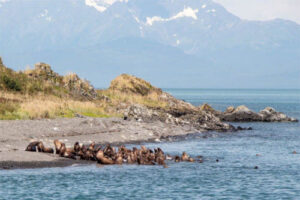Climate Change: Understanding Place-Based Identity as Sea Ice Vanishes
For many Alaskan Native and other Indigenous peoples and tribes across present-day Canada and the United States, climate change has directly affected traditional ways of life. Chuathbulak, a Yup’ik village in southwest Alaska, is made up of less than 100 people. The geographically isolated village is only accessible via boat or plane in the summer and by either plane or driving over frozen rivers during the winter. The isolation strains food availability within the community, as the village’s two grocery stores often only carry non-perishable items that have been flown in over hundreds of miles from the lower 48. Even when perishable items such as fruits and vegetables are made readily available, their price is often so high that families simply cannot afford to purchase them.
 The Food Bank of Alaska says it’s typical that a gallon of milk costs $10 and a loaf of bread $6 in some isolated communities, a stark difference from food prices in other parts of the United States. High prices coupled with Alaska’s high proportion of seasonal jobs, which are often dependent on fishing industries, leave many Natives unable to purchase all or most of their food at a grocery store.
The Food Bank of Alaska says it’s typical that a gallon of milk costs $10 and a loaf of bread $6 in some isolated communities, a stark difference from food prices in other parts of the United States. High prices coupled with Alaska’s high proportion of seasonal jobs, which are often dependent on fishing industries, leave many Natives unable to purchase all or most of their food at a grocery store.
Yet, Alaskan Native communities are no stranger to utilizing the land for subsistence, often hunting, fishing, and foraging to keep food costs low. This traditional way of life, however, is directly afflicted by climate change. Teresa Hunter, a resident of Chuathbulak, has noticed that her routine of salmon fishing and berry picking has been altered due to warmer summer and winter temperatures throughout the village. In previous years, Hunter would fish for salmon which came up the river in June and pick berries in late August. Now, the berries are ripening earlier, overlapping with the time she would spend fishing. When these two activities coincide, residents have a difficult time maintaining their livelihood and choosing between which activity is more profitable. As temperatures continue to climb, Hunter worries that it will be harder for her grandchildren to hunt and travel, too. Her way of life has been forever altered.
The National Aeronautics and Space Administration (NASA) states that in 2020 Arctic sea ice cover shrank to its second lowest extent since the 1970s. In the winter months, frozen seawater historically covers most of the Arctic Ocean and its neighboring seas. This sea ice varies in both extent and thickness with the changing seasons; the ice often thins and shrinks during late spring and summer and thickens and expands during fall and winter. The annual minimum extent of sea ice often occurs within the summer months when the temperatures in the Arctic are at its peak.
Yet in the past two decades, the minimum extent has dropped to its lowest ever recorded. A heat wave across Siberia in the spring directly triggered the early melt season in 2020, with Arctic temperatures almost 14-18 degrees Fahrenheit above average. This heat wave also triggered forest fires within the Arctic Circle, prompting the burning of approximately 10.9 million hectares of forest in Russia. Earlier melting events trigger thicker, multi-year ice to thaw, leaving a plethora of cascading, dangerous climate effects. The volatile variation in sea ice has the ability to influence regional and global weather patterns and ocean circulation. As sea ice continues to disappear, local Arctic livelihoods begin to unravel.
 The melting of sea ice does not bode well for other Alaska Native communities at the coastline. As the ocean continues to warm, sea level rise and associated erosion further encroaches on villages and communities. Residents of Newtok, another Yup’ik village, are currently in the process of becoming the first Americans to be relocated due to climate change. With the riverfront village losing approximately 70 feet of coastline each year, elders of the village felt it was best to relocate to preserve any semblance of their unique, Indigenous community.
The melting of sea ice does not bode well for other Alaska Native communities at the coastline. As the ocean continues to warm, sea level rise and associated erosion further encroaches on villages and communities. Residents of Newtok, another Yup’ik village, are currently in the process of becoming the first Americans to be relocated due to climate change. With the riverfront village losing approximately 70 feet of coastline each year, elders of the village felt it was best to relocate to preserve any semblance of their unique, Indigenous community.
The culmination of various factors — erosion, sea level rise, rising temperatures, and alterations in hunting, fishing and foraging — will continue to impact the traditional practice and livelihood of Indigenous populations across the Arctic. Yet, stories of climate change and how to prepare for it are often passed down over hundreds of years through tribal elders. For Hunter, she remembers how, when she was a teenager, an elder of her village came to her school and explained how weather from the lower 48 would come up to Alaska.
 This innate recognition of changes in the environment is often emblematic of Indigenous understanding of place. Authors Leilani Nishime and Kim D. Hester Williams in their book Racial Ecologies note that place is an expression of relationships between people, ecosystems, and other living beings that share the land. Knowledge is therefore interrelated and passed between humans and nonhumans through the environment. Place is not merely a geographical location, but rather, place is embedded in societies and beings. Indigenous conceptions of place are often not understood in a settler-colonialist North American (United States and Canada) context. The environment is not an “out there” phenomenon, but rather, it is of each of us. Our actions towards the environment, therefore, affect us because we are the environment.
This innate recognition of changes in the environment is often emblematic of Indigenous understanding of place. Authors Leilani Nishime and Kim D. Hester Williams in their book Racial Ecologies note that place is an expression of relationships between people, ecosystems, and other living beings that share the land. Knowledge is therefore interrelated and passed between humans and nonhumans through the environment. Place is not merely a geographical location, but rather, place is embedded in societies and beings. Indigenous conceptions of place are often not understood in a settler-colonialist North American (United States and Canada) context. The environment is not an “out there” phenomenon, but rather, it is of each of us. Our actions towards the environment, therefore, affect us because we are the environment.
The view of the Arctic as a vast space devoid of humans and open to resource extraction erases Indigenous place. Recently, the U.S. government has finalized plans to open the Arctic National Wildlife Refuge in Alaska to oil and gas development. The drilling would destroy large swaths of protected wilderness across the state. Yet, this view of wilderness continuously minimizes Indigenous livelihood.
For Hunter and other Alaska Natives, the compounding effects of climate change and food insecurity will produce human vulnerability unseen before. A recent 2019 study conducted by the U.S. Army Corps of Engineers and researchers at the University of Alaska, Fairbanks illustrates the compounding problems Alaska Native communities face. Out of 187 communities surveyed, 102 communities face a high threat of issues such as melting permafrost, erosion, or flooding, with 19 communities facing more than one simultaneously. With many of these same communities experiencing food insecurity, the rate at which relocation of communities occurs will surely rise in the near future.
I worry that our conceptions of anthropogenic climate change as an “out there” phenomenon further marginalize Indigenous peoples of the Arctic, many of whom are already experiencing some of the consequences of the climate crisis. If government agencies continue to ignore the sanctity of human-environment relationships, the livelihood of the Arctic is directly under fire.
We must rework our perceptions of the environment and expand our ideas on place to better understand the repercussions of our extractive, polluting, and climate-change inducing practices.
 Brandon Rothrock – Rachel Carson Council Fellow
Brandon Rothrock – Rachel Carson Council Fellow
Brandon Rothrock is working on a Master of Arts in Geography and a Graduate Certificate in Women’s and Gender Studies at theWest Virginia University. His RCC project is on climate justice and the LGBTQ+ community. [email protected]






